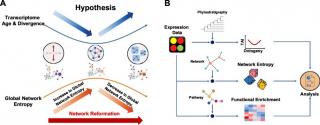Feb, 2022

The hourglass model is a popular evo-devo model depicting that the developmental constraints in the middle of a developmental process are higher, and hence the phenotypes are evolutionarily more conserved, than those that occur in early and late ontogeny stages. Although this model has been supported by studies analyzing developmental gene expression data, the evolutionary explanation and molecular mechanism behind this phenomenon are not fully understood yet. To approach this problem, Raff proposed a hypothesis and claimed that higher interconnectivity among elements in an organism during organogenesis resulted in the larger constraints at the mid-developmental stage. By employing stochastic network analysis and gene-set pathway analysis, we aim to demonstrate such changes of interconnectivity claimed in Raff’s hypothesis. We first compared the changes of network randomness among developmental processes in different species by measuring the stochasticity within the biological network in each developmental stage. By tracking the network entropy along each developmental process, we found that the network stochasticity follows an anti-hourglass trajectory, and such a pattern supports Raff’s hypothesis in dynamic changes of interconnections among biological modules during development. To understand which biological functions change during the transition of network stochasticity, we sketched out the pathway dynamics along the developmental stages and found that species may activate similar groups of biological processes across different stages. Moreover, higher interspecies correlations are found at the mid-developmental stages.